Astronomers identified the largest stellar black hole yet discovered in the Milky Way, with a mass 33 times that of the Sun, according to a study published on Tuesday.
Astronomers discover largest black hole in Milky Way: Study retrieved 20 April 2024 from https://phys.org/news/2024-04-astronomers-largest-black-hole-milky.html
This document is subject to copyright. Apart from any fair dealing for the purpose of private study or research, no part may be reproduced without the written permission. The content is provided for information purposes only.Use this form if you have come across a typo, inaccuracy or would like to send an edit request for the content on this page. For general inquiries, please use ourThank you for taking time to provide your feedback to the editors.
Your feedback is important to us. However, we do not guarantee individual replies due to the high volume of messages.to let the recipient know who sent the email. Neither your address nor the recipient's address will be used for any other purpose. The information you enter will appear in your e-mail message and is not retained by Phys.org in any form.Get weekly and/or daily updates delivered to your inbox.
Physics News Science News Technology News Physics Materials Nanotech Technology Science
United States Latest News, United States Headlines
Similar News:You can also read news stories similar to this one that we have collected from other news sources.
 Astronomers Discover Heaviest Stellar Black Hole in the Milky WayThe black hole lurks just 2,000 light-years away in the constellation Aquila.
Astronomers Discover Heaviest Stellar Black Hole in the Milky WayThe black hole lurks just 2,000 light-years away in the constellation Aquila.
Read more »
 Astronomers unveil strong magnetic fields spiraling at the edge of Milky Way's central black holeA new image from the Event Horizon Telescope (EHT) collaboration has uncovered strong and organized magnetic fields spiraling from the edge of the supermassive black hole Sagittarius A* (Sgr A*).
Astronomers unveil strong magnetic fields spiraling at the edge of Milky Way's central black holeA new image from the Event Horizon Telescope (EHT) collaboration has uncovered strong and organized magnetic fields spiraling from the edge of the supermassive black hole Sagittarius A* (Sgr A*).
Read more »
 Astronomers unveil strong magnetic fields spiraling at the edge of Milky Way's central black holeA new image from the Event Horizon Telescope (EHT) collaboration—which includes scientists from the Center for Astrophysics | Harvard & Smithsonian (CfA)— has uncovered strong and organized magnetic fields spiraling from the edge of the supermassive black hole Sagittarius A* (Sgr A*).
Astronomers unveil strong magnetic fields spiraling at the edge of Milky Way's central black holeA new image from the Event Horizon Telescope (EHT) collaboration—which includes scientists from the Center for Astrophysics | Harvard & Smithsonian (CfA)— has uncovered strong and organized magnetic fields spiraling from the edge of the supermassive black hole Sagittarius A* (Sgr A*).
Read more »
 Astronomers Uncover Micro 'Galaxy' Orbiting the Milky WayThe weird, faint star system—the tiniest Milky Way satellite ever found—could be under the influence of dark matter.
Astronomers Uncover Micro 'Galaxy' Orbiting the Milky WayThe weird, faint star system—the tiniest Milky Way satellite ever found—could be under the influence of dark matter.
Read more »
 New study calls into question prior study results that found tumor transmission slowing in Tasmanian devilsA trio of biologists and veterinarians with CRG Barcelona, the University of Cambridge and The Barcelona Institute of Science and Technology, respectively, has found evidence contradicting results found by a prior team of researchers who claimed that they had found that tumor transmission in Tasmanian devils was slowing.
New study calls into question prior study results that found tumor transmission slowing in Tasmanian devilsA trio of biologists and veterinarians with CRG Barcelona, the University of Cambridge and The Barcelona Institute of Science and Technology, respectively, has found evidence contradicting results found by a prior team of researchers who claimed that they had found that tumor transmission in Tasmanian devils was slowing.
Read more »
 The Large Magellanic Cloud: A Satellite Galaxy of the Milky WayThe Large Magellanic Cloud (LMC) is the Milky Way’s most massive satellite galaxy. Scientists are interested in how star formation in the LMC might have been different than in the Milky Way.
The Large Magellanic Cloud: A Satellite Galaxy of the Milky WayThe Large Magellanic Cloud (LMC) is the Milky Way’s most massive satellite galaxy. Scientists are interested in how star formation in the LMC might have been different than in the Milky Way.
Read more »
